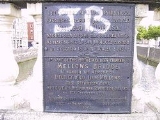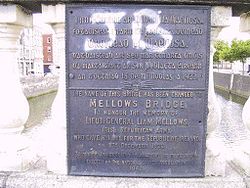
Mellows Bridge
Encyclopedia
Mellows Bridge is a road bridge spanning the River Liffey
, in Dublin, Ireland
and joining Queen Street and Arran Quay to the south quays.
In 1683, a stone bridge called Arran Bridge or Arons Bridge was built in a location between the upstream Bloody Bridge (see Rory O'More Bridge
) and the downstream Bridge of Dublin (see Fr. Mathew Bridge
). Construction was funded by landowner William Ellis, and Dublin Corporation
. It was named after Richard, Earl of Arran, second son of the Duke of Ormonde. From a drawing made by Francis Place in 1699, it appears to have been a four-span stone arched bridge.
It was also known as Bridewell Bridge due to its proximity to the Smithfield Bridewell, and as Ellis's Bridge because of its association with Sir William and Sir John Ellis.
This structure stood for 80 years, but was swept away by a flood in 1763. The collapse was described by George Semple
as being an unlucky accident when a raft of timber was swiftly carried downstream in a flood where it got lodged across the middle arch. The water flow increased under the raft at this point, and since the piers of the bridge were built on top of the river bed - This raft of timber obstructing the current of the surface, in like manner increased the power of it at the bottom and within the space of a few hours totally demolished the bridge.
Designed by Charles Valency (a military engineer) a replacement bridge on the same site was built between 1764 and 1768 as a three elliptical arch stone bridge with a total span of 42 m, and named Queens Bridge after Charlotte of Mecklenburg
, queen consort of George III
.
The bridge was renamed for the legendary Queen Maeve
at a meeting of the Municipal Council on 2 January 1922. However, it was renamed again in 1942 to its current name, after Lieutenant General Liam Mellows
Irish Republican army who was executed
during the Irish Civil War
.
At almost 250 years old, Mellow's Bridge remains the oldest of all Dublin city bridges still in use, although the parapets were replaced with cast iron balustrades and stone copings between 1816 and 1818.

River Liffey
The Liffey is a river in Ireland, which flows through the centre of Dublin. Its major tributaries include the River Dodder, the River Poddle and the River Camac. The river supplies much of Dublin's water, and a range of recreational opportunities.-Name:The river was previously named An Ruirthech,...
, in Dublin, Ireland
Ireland
Ireland is an island to the northwest of continental Europe. It is the third-largest island in Europe and the twentieth-largest island on Earth...
and joining Queen Street and Arran Quay to the south quays.
In 1683, a stone bridge called Arran Bridge or Arons Bridge was built in a location between the upstream Bloody Bridge (see Rory O'More Bridge
Rory O'More Bridge
Rory O'More Bridge is a road bridge spanning the River Liffey in Dublin, Ireland and joining Watling Street to Ellis Street and the north quays....
) and the downstream Bridge of Dublin (see Fr. Mathew Bridge
Fr. Mathew Bridge
thumb|19th Century print by [[William Henry Bartlett|W.H. Bartlett]] of the [[Four Courts]] and Whitworth Bridge Father Mathew Bridge is a road bridge spanning the River Liffey in Dublin, Ireland and joining Merchants Quay to Church Street and the north quays.The site of the bridge is understood...
). Construction was funded by landowner William Ellis, and Dublin Corporation
Dublin Corporation
Dublin Corporation , known by generations of Dubliners simply as The Corpo, is the former name given to the city government and its administrative organisation in Dublin between 1661 and 1 January 2002...
. It was named after Richard, Earl of Arran, second son of the Duke of Ormonde. From a drawing made by Francis Place in 1699, it appears to have been a four-span stone arched bridge.
It was also known as Bridewell Bridge due to its proximity to the Smithfield Bridewell, and as Ellis's Bridge because of its association with Sir William and Sir John Ellis.
This structure stood for 80 years, but was swept away by a flood in 1763. The collapse was described by George Semple
George Semple
George Semple was a notable Irish builder and architect.-Life:His earliest known work is the steeple, in height, of St. Patrick's Cathedral, Dublin, which he designed and erected in 1749.He also built St...
as being an unlucky accident when a raft of timber was swiftly carried downstream in a flood where it got lodged across the middle arch. The water flow increased under the raft at this point, and since the piers of the bridge were built on top of the river bed - This raft of timber obstructing the current of the surface, in like manner increased the power of it at the bottom and within the space of a few hours totally demolished the bridge.
Designed by Charles Valency (a military engineer) a replacement bridge on the same site was built between 1764 and 1768 as a three elliptical arch stone bridge with a total span of 42 m, and named Queens Bridge after Charlotte of Mecklenburg
Charlotte of Mecklenburg-Strelitz
Charlotte of Mecklenburg-Strelitz was the Queen consort of the United Kingdom as the wife of King George III...
, queen consort of George III
George III of the United Kingdom
George III was King of Great Britain and King of Ireland from 25 October 1760 until the union of these two countries on 1 January 1801, after which he was King of the United Kingdom of Great Britain and Ireland until his death...
.
The bridge was renamed for the legendary Queen Maeve
Medb
Medb – Middle Irish: Meḋḃ, Meaḋḃ; early modern Irish: Meadhbh ; reformed modern Irish Méabh, Medbh; sometimes Anglicised Maeve, Maev or Maive – is queen of Connacht in the Ulster Cycle of Irish mythology...
at a meeting of the Municipal Council on 2 January 1922. However, it was renamed again in 1942 to its current name, after Lieutenant General Liam Mellows
Liam Mellows
Liam Mellows was an Irish Republican and Sinn Féin politician. Born in England, Mellows grew up in County Wexford in Ireland. He was active with the Irish Republican Brotherhood and Irish Volunteers, and participated in the Easter Rising in County Galway, and the War of Independence...
Irish Republican army who was executed
Executions during the Irish Civil War
The executions during the Irish Civil War took place during the guerrilla phase of the Irish Civil War . This phase of the war was bitter, and both sides, the government forces of the Irish Free State and the anti-Treaty Irish Republican Army insurgents, used executions and terror in what...
during the Irish Civil War
Irish Civil War
The Irish Civil War was a conflict that accompanied the establishment of the Irish Free State as an entity independent from the United Kingdom within the British Empire....
.
At almost 250 years old, Mellow's Bridge remains the oldest of all Dublin city bridges still in use, although the parapets were replaced with cast iron balustrades and stone copings between 1816 and 1818.
Nomenclature
As with other bridges on the Liffey in Dublin, and largely because of the many name changes, Mellow's Bridge is known locally by several names, including: Queen's Bridge, Queen's Street Bridge, Queen Maeve Bridge, and Mellowes Bridge (with an "e").

